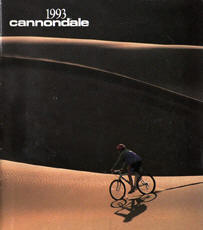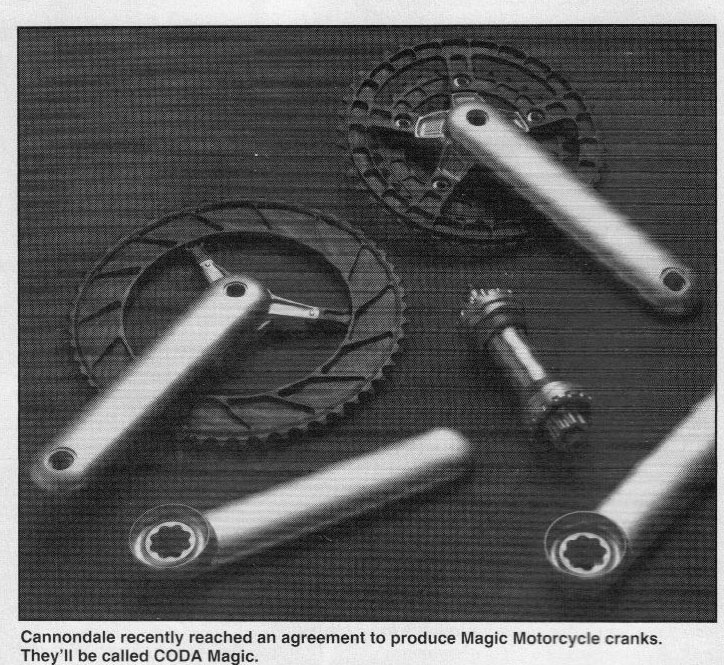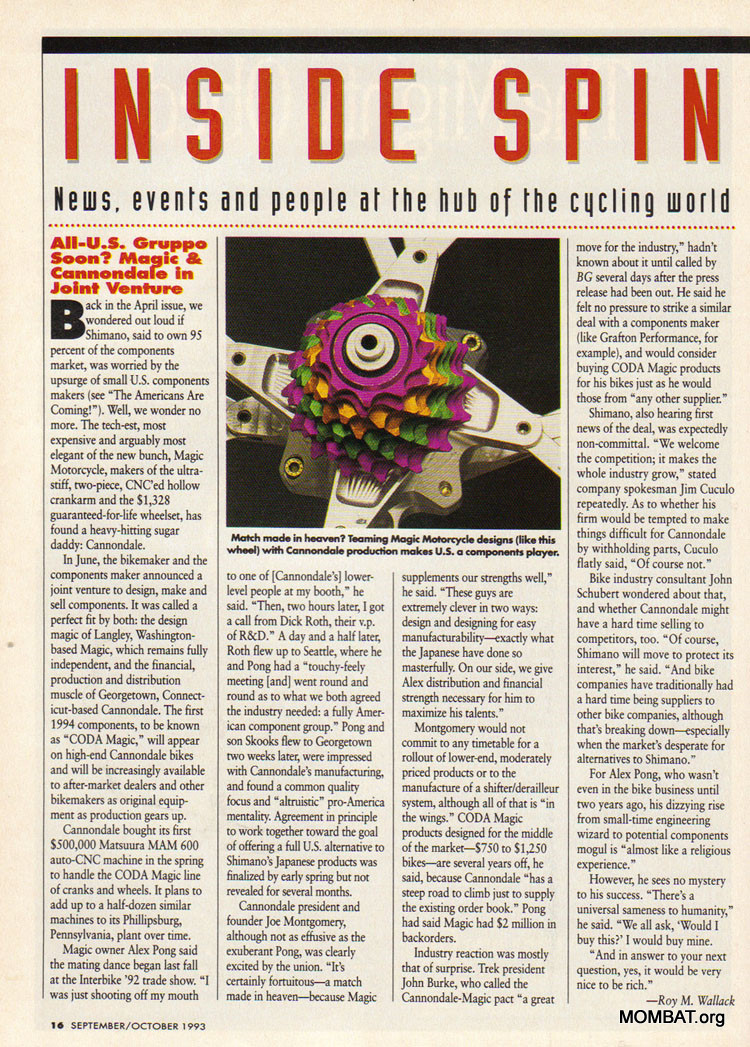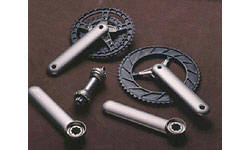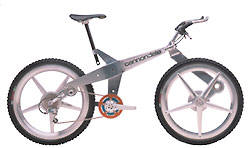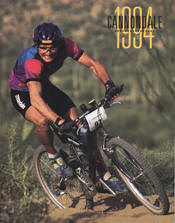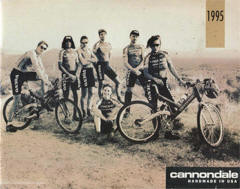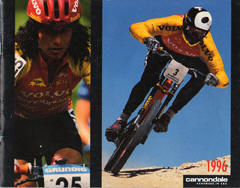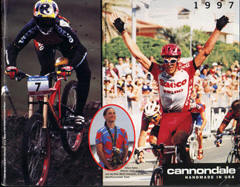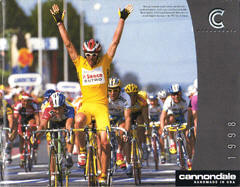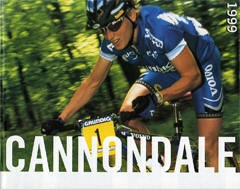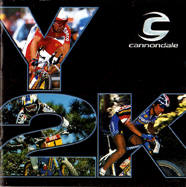Click links below to view the Cannondale bikes in our collection:
1984 24"/26" wheels
1986 SM600
1991 SE1000
1992 Delta V 1000
1997 "Stars and Stripes"
1997 Tinker Juarez team bike
1998 Super V 1000 Freeride
1999 F2000
1999 Super V Raven 700
MOMBAT links
Share this page with your friends:
Tweet
Tweet
Hours
Monday-Friday: 10-6
Saturday: 10-5
Sunday: Closed
MOMBAT t-shirts
Show your support for the MOMBAT with this great looking t-shirt.
"It doesnt get any easier, you just get faster." Greg LeMond
If you found something useful on this site, please consider making a donation to help defray the costs of bringing it to you. Thanks Jeff

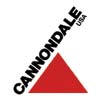
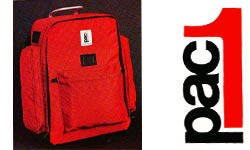
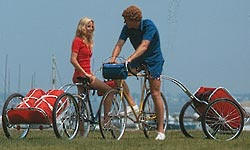
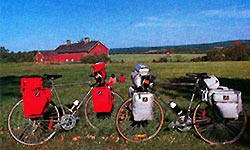
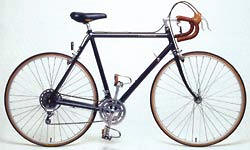
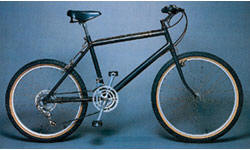
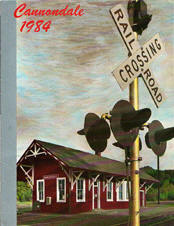

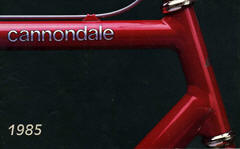
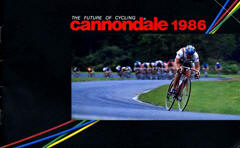

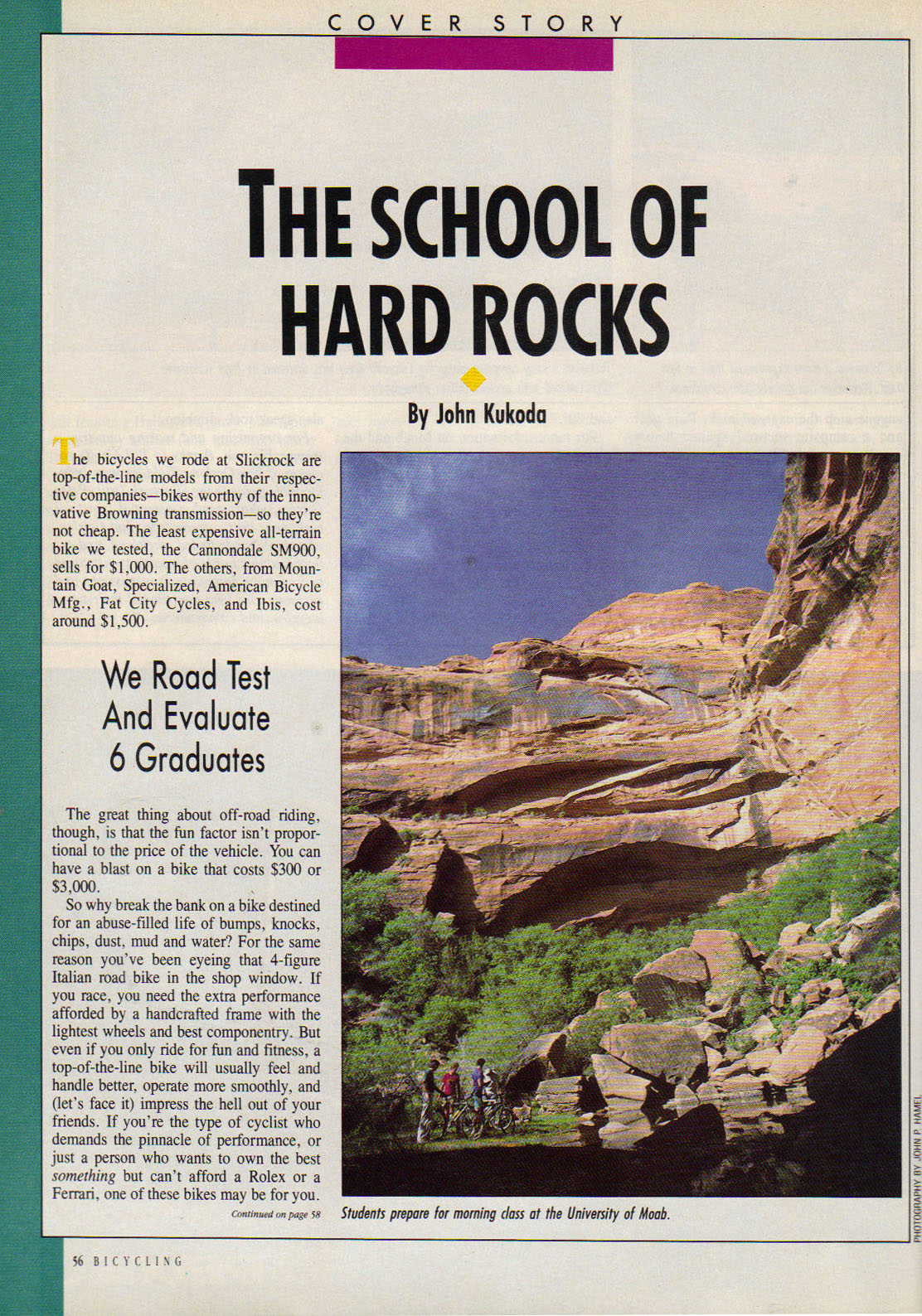
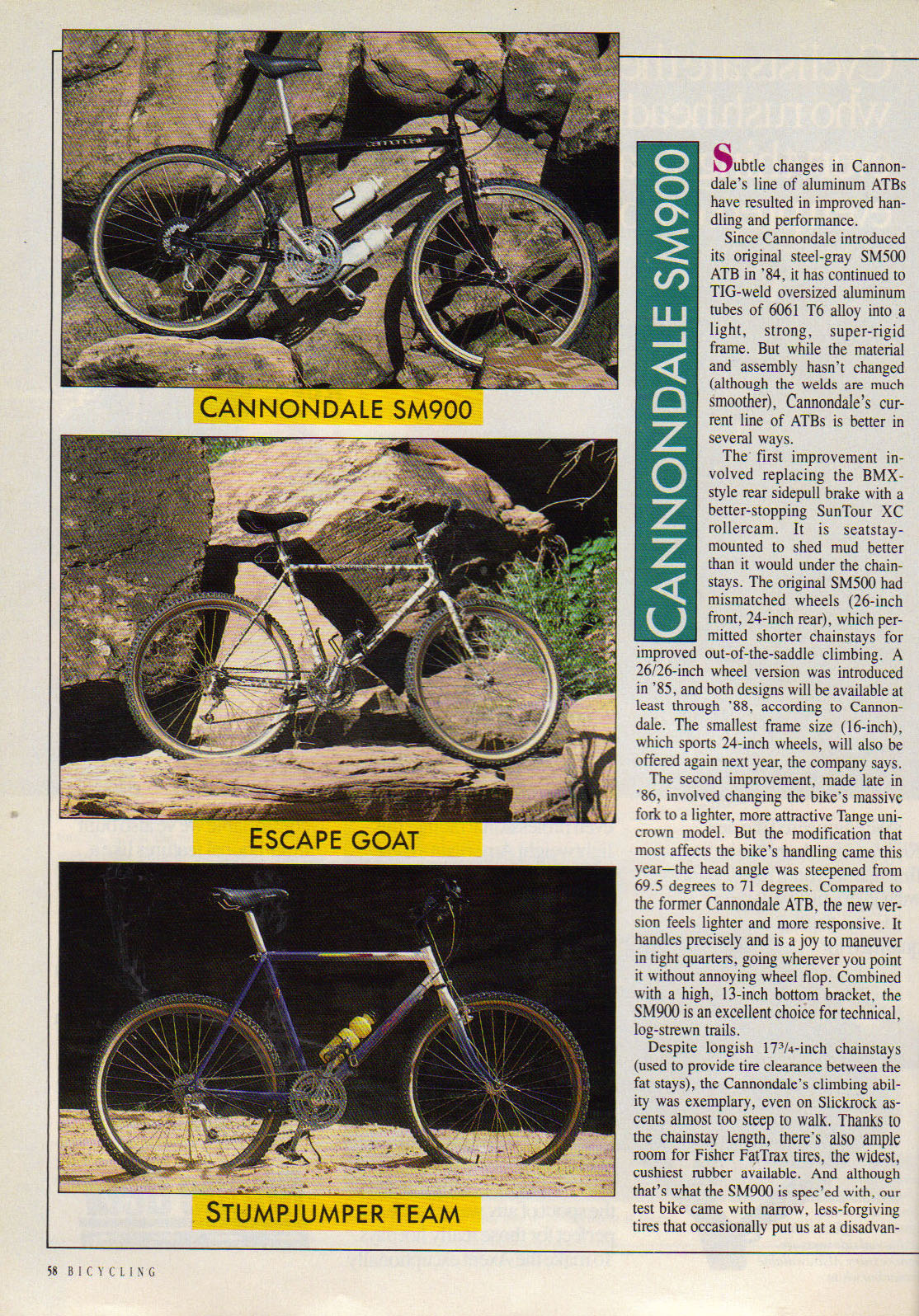
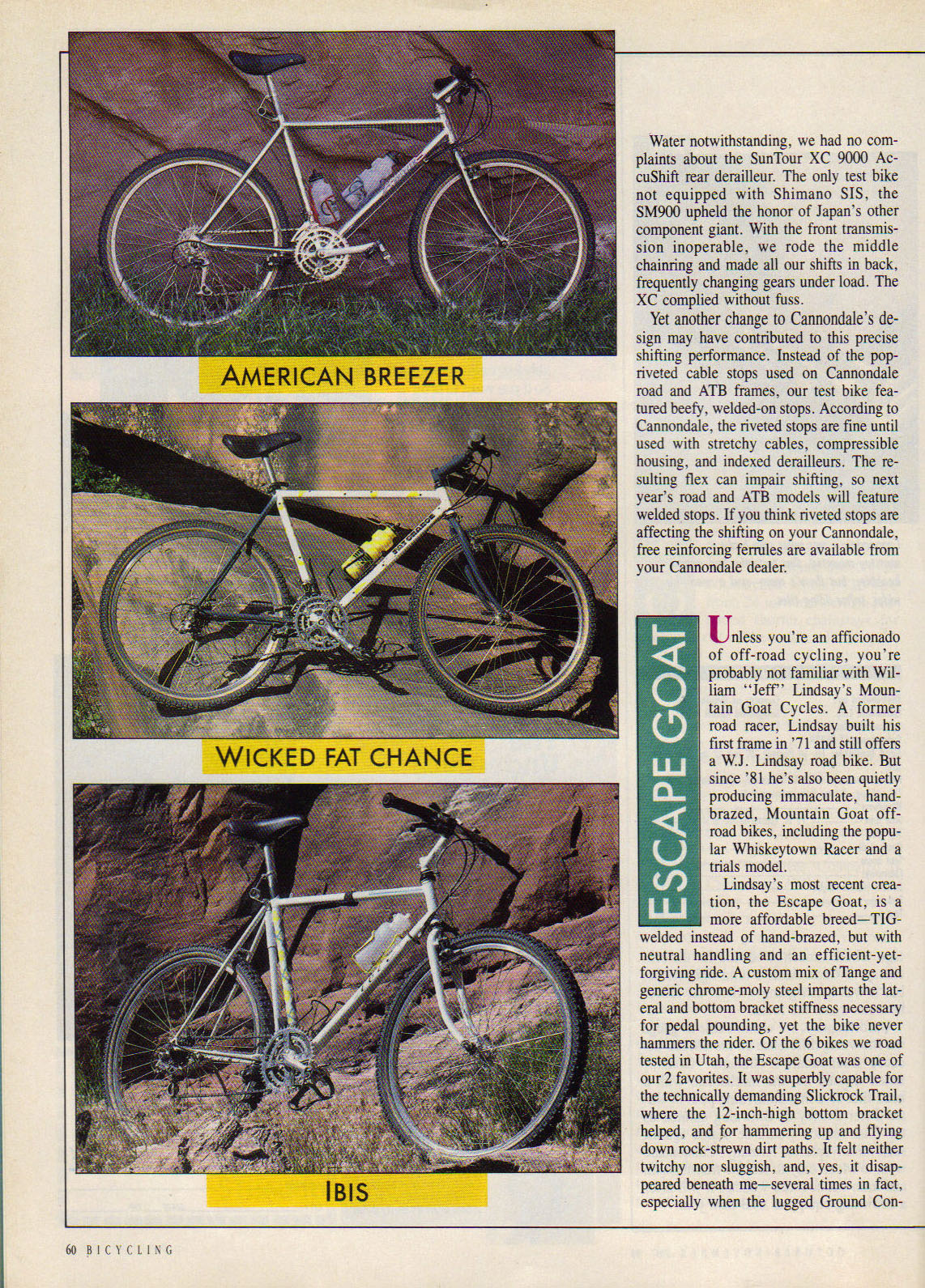
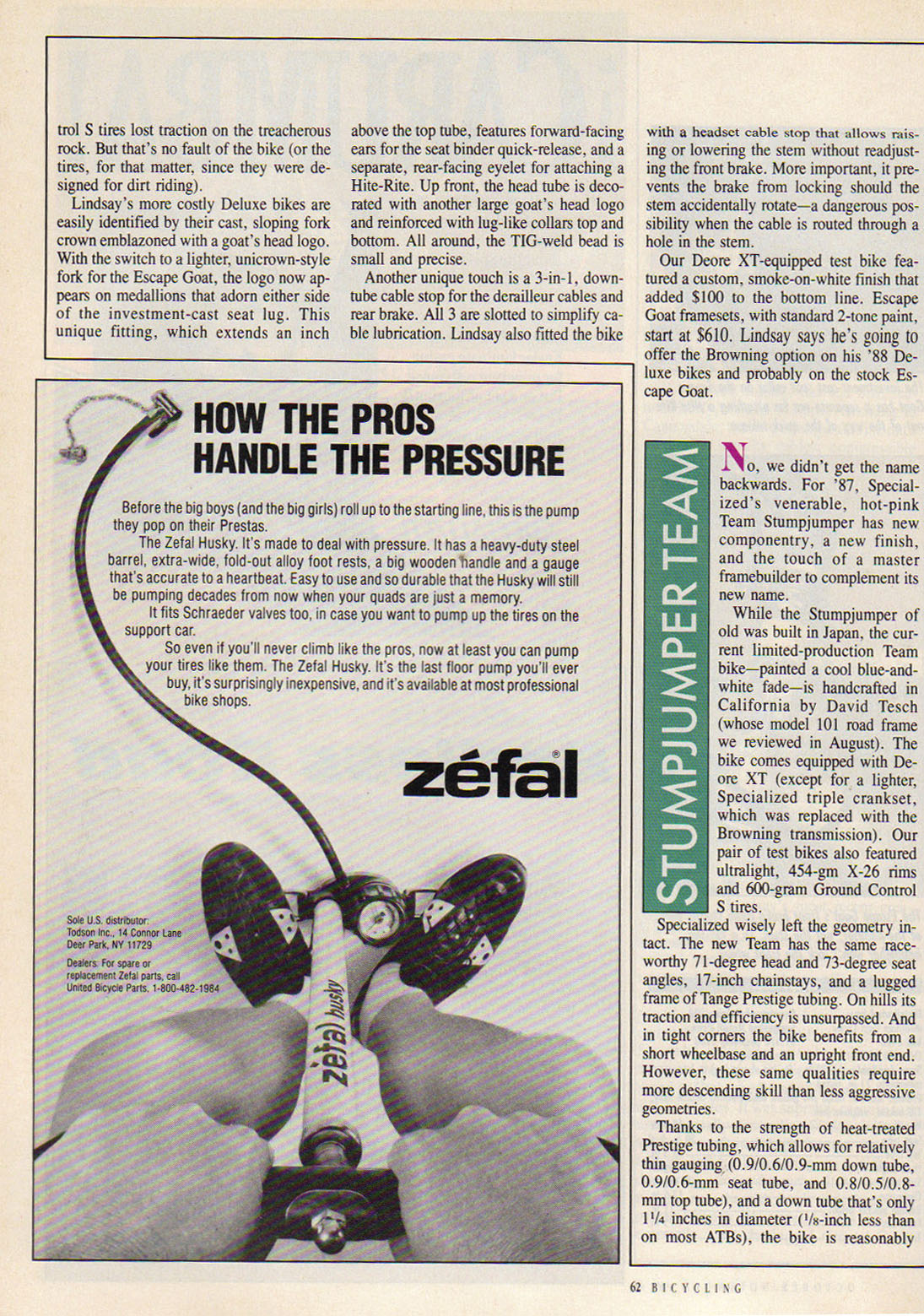
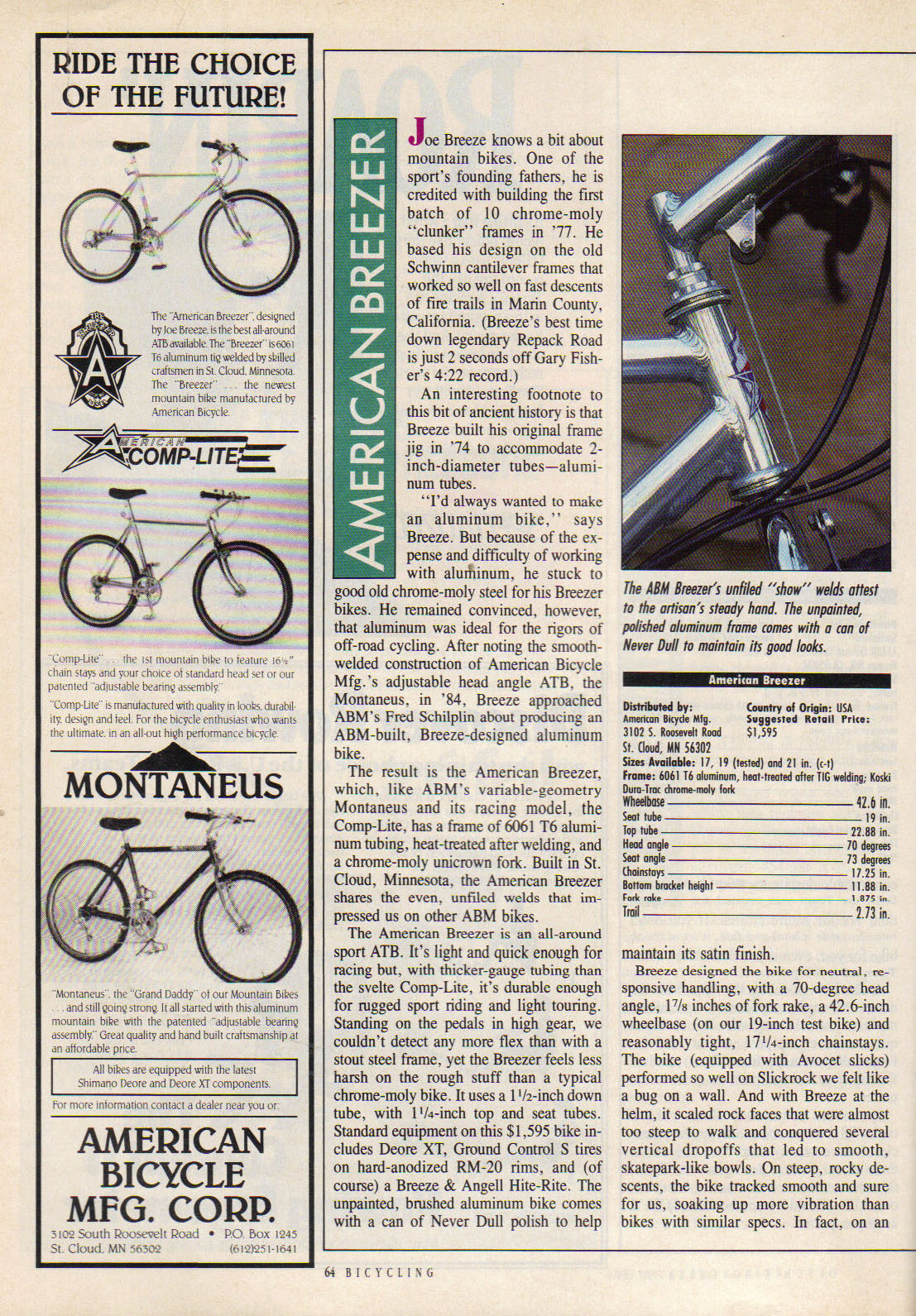
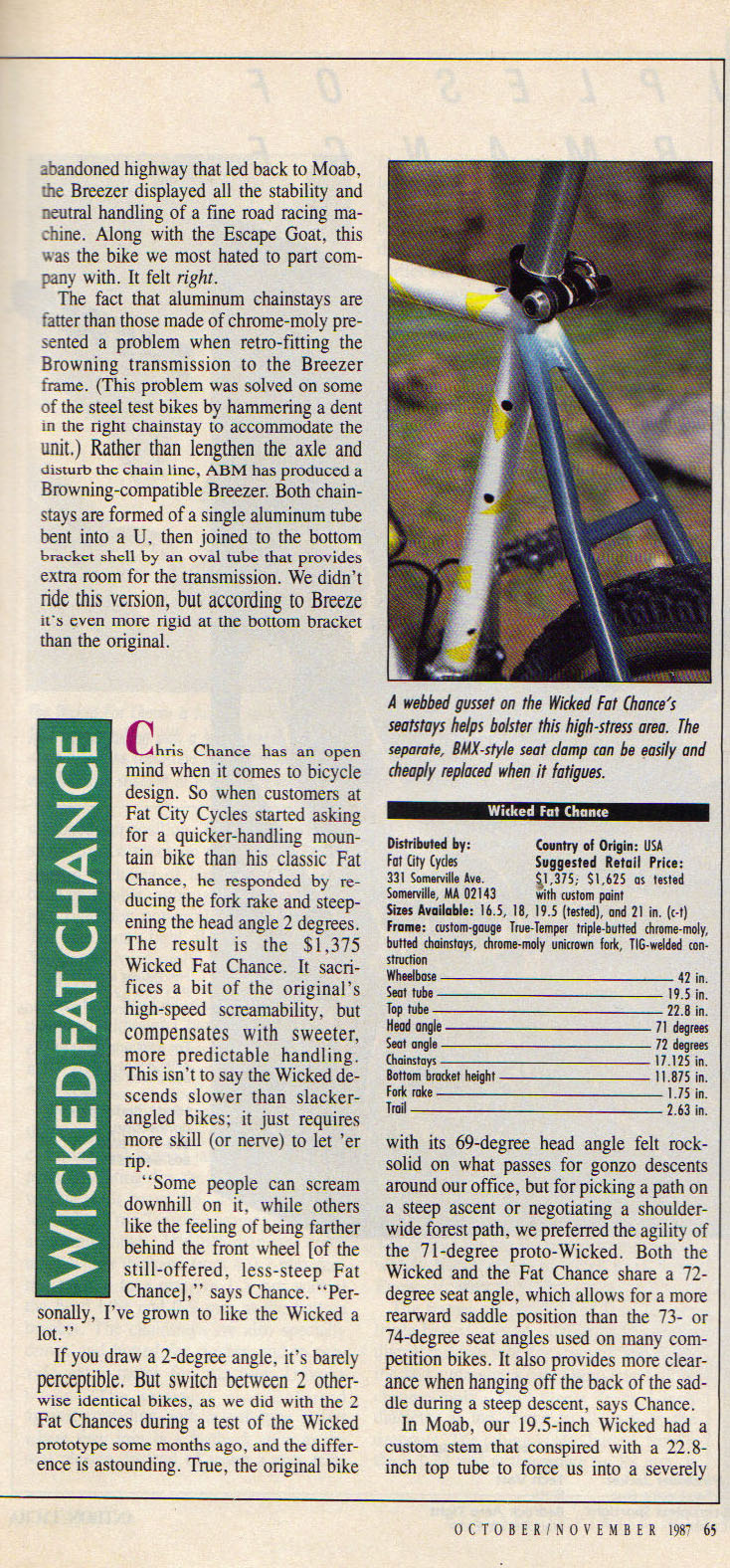
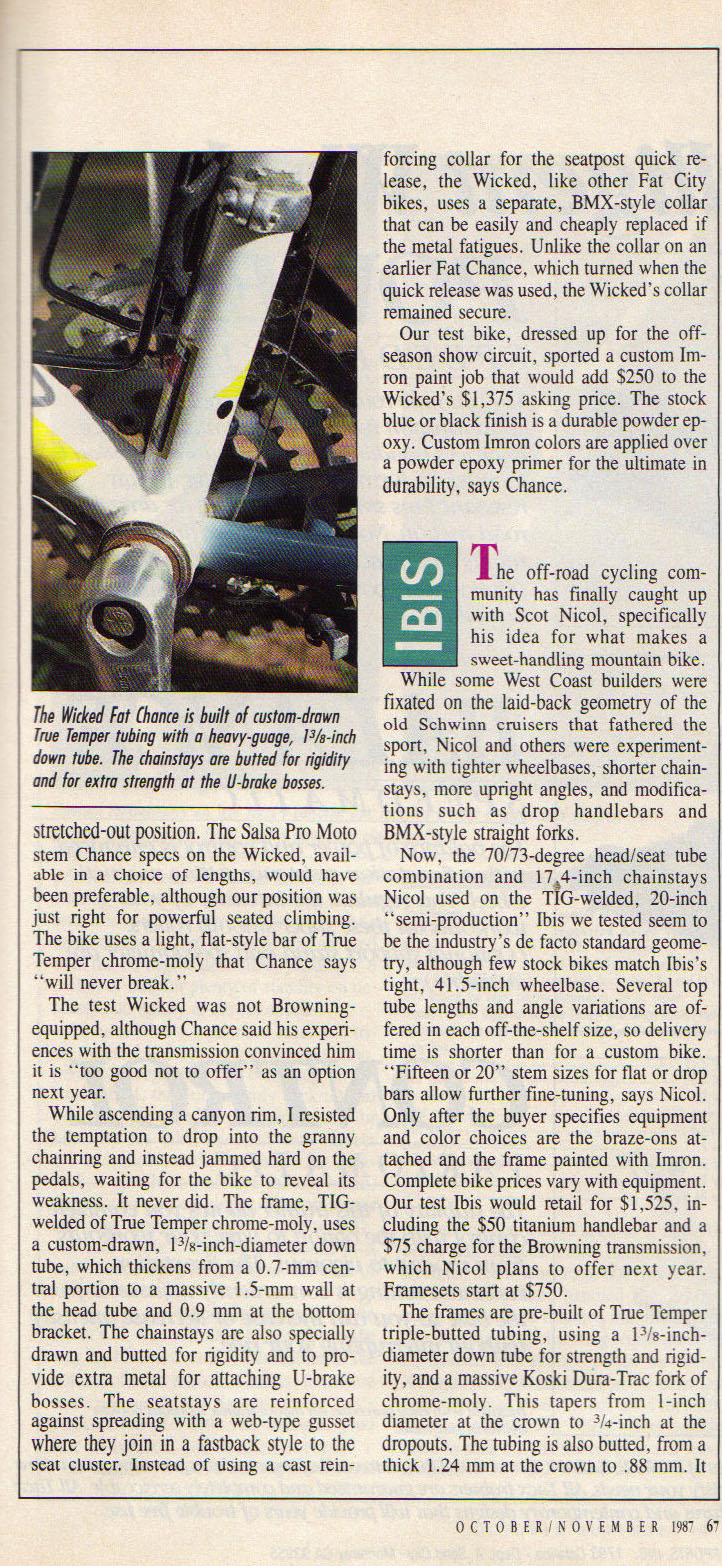


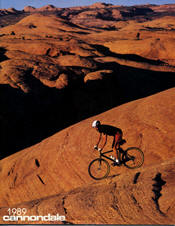
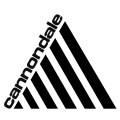 In addition to the new logo, all Cannondale
mountain bikes now have a cantilevered rear replaceable drop out, 16.9"
stays and dual 26" wheels on all models. The Competition Series
consists of the SM2000, SM1000, SM800 and SM700 all of which use .25"
less trail (Cannondale aluminum fork on the SM2000 and Ritchey Logic on
all others). The SM2000 adds a Cannondale made 285 stem (285g) to
the new Rapid Fire Shimano Deore XT parts group and weighs in at 24.9
pounds. The SM1000 substitutes the DX Rapid Fire group and weighs
25.8 pounds. The Red Shred SM800 is joined by the Chameleon SM800
which uses the Shimano Deore LX group with the DX shifters and weighs in
at 27.3 pounds. The sloping top tube model still uses the 13" high
bottom bracket. The SM700 (26.9 pound) uses similar parts to the
SM800 but puts them on the regular level top tube frame with an
Odyssey Aereator seat post pump. The SM600, SM500 and SM 400 use
the Exage 500 LX, Suntour XCE and Suntour XCM components.
Cannondale also introduces the SH400 and SH600 hybrid models with
mountain bike components and 700 x 35 knobby tires.
In addition to the new logo, all Cannondale
mountain bikes now have a cantilevered rear replaceable drop out, 16.9"
stays and dual 26" wheels on all models. The Competition Series
consists of the SM2000, SM1000, SM800 and SM700 all of which use .25"
less trail (Cannondale aluminum fork on the SM2000 and Ritchey Logic on
all others). The SM2000 adds a Cannondale made 285 stem (285g) to
the new Rapid Fire Shimano Deore XT parts group and weighs in at 24.9
pounds. The SM1000 substitutes the DX Rapid Fire group and weighs
25.8 pounds. The Red Shred SM800 is joined by the Chameleon SM800
which uses the Shimano Deore LX group with the DX shifters and weighs in
at 27.3 pounds. The sloping top tube model still uses the 13" high
bottom bracket. The SM700 (26.9 pound) uses similar parts to the
SM800 but puts them on the regular level top tube frame with an
Odyssey Aereator seat post pump. The SM600, SM500 and SM 400 use
the Exage 500 LX, Suntour XCE and Suntour XCM components.
Cannondale also introduces the SH400 and SH600 hybrid models with
mountain bike components and 700 x 35 knobby tires. 
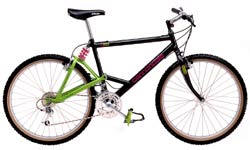 The big news for 1991 is the introduction
of Cannondale's first full suspension design, the E.S.T. (Elevated
Suspension Technology). The front suspension was
handled by a Girvin Flex stem. According to the catalog: "And
because the swing arm is hinged above the chain, not of you pedaling
energy gets lost compressing the shock." Rear suspension
designs always made mounting cantilever brakes difficult so Cannondale
came up with the "Force 40" brake routing. The name came from the
40% increase in stopping power and eliminated the need for a cable stop
on the frame. A pulley was mounted to the frame while the cable
housing ended at a machined aluminum stop mounted on the straddle wire.
These led to a very mushy feeling brake that was difficult to adjust.
If adjusted properly they were pretty powerful but it was to be soon
updated by Cannondale. For '91, there were three E.S.T.
models: SE Omega, SE2000 and
SE1000. All three used the same
frame, Force 40 brakes, Pepperoni aluminum fork and Girvin Flex Stem but
differed in component spec. The Omega used a Mavic headset, Cook
Bros crank and bottom bracket, XT clip less pedals, Hyperlite bars and a
Suntour XC Pro drive train. The popular SE2000, as seen above,
used a Deore XT thumb shift group while the SE1000 was a Suntour XC Comp
bike.
The big news for 1991 is the introduction
of Cannondale's first full suspension design, the E.S.T. (Elevated
Suspension Technology). The front suspension was
handled by a Girvin Flex stem. According to the catalog: "And
because the swing arm is hinged above the chain, not of you pedaling
energy gets lost compressing the shock." Rear suspension
designs always made mounting cantilever brakes difficult so Cannondale
came up with the "Force 40" brake routing. The name came from the
40% increase in stopping power and eliminated the need for a cable stop
on the frame. A pulley was mounted to the frame while the cable
housing ended at a machined aluminum stop mounted on the straddle wire.
These led to a very mushy feeling brake that was difficult to adjust.
If adjusted properly they were pretty powerful but it was to be soon
updated by Cannondale. For '91, there were three E.S.T.
models: SE Omega, SE2000 and
SE1000. All three used the same
frame, Force 40 brakes, Pepperoni aluminum fork and Girvin Flex Stem but
differed in component spec. The Omega used a Mavic headset, Cook
Bros crank and bottom bracket, XT clip less pedals, Hyperlite bars and a
Suntour XC Pro drive train. The popular SE2000, as seen above,
used a Deore XT thumb shift group while the SE1000 was a Suntour XC Comp
bike. 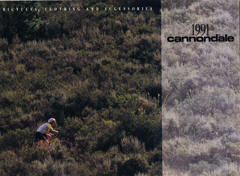
 suspension into an oversized
head tube that runs on a 45mm sealed cartridge bearing head set. The fork
blades are the oversized aluminum Pepperoni blades. Traditional
telescoping forks were having rigidity issues since the small diameter fork
blades moved independently of each other and would bind when side-loaded.
With the rigid Pepperoni blades this problem was greatly reduced. The fork
used an air spring with a hydraulic damping unit which was adjustable using the
"Dampening Dial" located on top of the stem. The fork rode on 4 sets of
needle bearing which eliminated much of the stiction of the traditional forks.
The biggest negative of the system was the lack of compatibility. Other
bikes didn't have a large enough head tube to accept the system so it could not
be retrofitted to other bikes. It also required the use of a Cannondale
specific stem. The Delta V was added to the E.S.T. rear suspension on the
Delta V2000 (Deore XT. 27.5 pound) and Delta V 1000 (XC Comp Micro Drive. 27
pound). The Delta V 900 was the hard tail version which used Deore LX
parts and weighed 26 pounds. The 3.0 Series continues of with the M2000
(Pepperoni fork, Force 40, Deore XT, 24.5 pounds), M1000 (Pepperoni fork, Force
40 brakes, Suntour XC Comp Micro Drive, 24.0 pounds), M800 (Beast of the East,
13" bottom bracket, Pepperoni fork, Force 40 brakes, Deore LX parts, rear
cantilever brake, 25.5 pounds), M700 (Pepperoni fork, Force 40 brakes, Deore LX
parts, 25.5 pounds), M500 (Cro-moly fork, Exage 500 LX parts, traditional
brakes, 27.5 pounds) and M400 (Cro-moly fork, traditional brake routing, Suntour
XCM Lite, 27.5 pounds). The M700 and above all use thumb shifters as
the STI push-push and Suntour X-Press shifters have fallen out of favor with
"serious" riders.
suspension into an oversized
head tube that runs on a 45mm sealed cartridge bearing head set. The fork
blades are the oversized aluminum Pepperoni blades. Traditional
telescoping forks were having rigidity issues since the small diameter fork
blades moved independently of each other and would bind when side-loaded.
With the rigid Pepperoni blades this problem was greatly reduced. The fork
used an air spring with a hydraulic damping unit which was adjustable using the
"Dampening Dial" located on top of the stem. The fork rode on 4 sets of
needle bearing which eliminated much of the stiction of the traditional forks.
The biggest negative of the system was the lack of compatibility. Other
bikes didn't have a large enough head tube to accept the system so it could not
be retrofitted to other bikes. It also required the use of a Cannondale
specific stem. The Delta V was added to the E.S.T. rear suspension on the
Delta V2000 (Deore XT. 27.5 pound) and Delta V 1000 (XC Comp Micro Drive. 27
pound). The Delta V 900 was the hard tail version which used Deore LX
parts and weighed 26 pounds. The 3.0 Series continues of with the M2000
(Pepperoni fork, Force 40, Deore XT, 24.5 pounds), M1000 (Pepperoni fork, Force
40 brakes, Suntour XC Comp Micro Drive, 24.0 pounds), M800 (Beast of the East,
13" bottom bracket, Pepperoni fork, Force 40 brakes, Deore LX parts, rear
cantilever brake, 25.5 pounds), M700 (Pepperoni fork, Force 40 brakes, Deore LX
parts, 25.5 pounds), M500 (Cro-moly fork, Exage 500 LX parts, traditional
brakes, 27.5 pounds) and M400 (Cro-moly fork, traditional brake routing, Suntour
XCM Lite, 27.5 pounds). The M700 and above all use thumb shifters as
the STI push-push and Suntour X-Press shifters have fallen out of favor with
"serious" riders.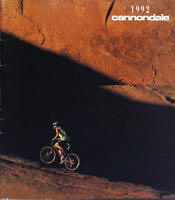
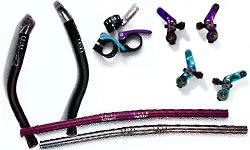 The Super V sports a "V"
configured frame with a new swing arm suspended by a Fox air shock.
The Super V3000 uses the top line Shimano XTR components, Delta V
suspension fork and is listed at 25.5 pounds. The Delta V full
suspension models continues with the Delta V2000 (Shimano XT, 27.5
pounds) and Delta V1000 (Suntour XC Comp Micro Drive, 27.0 pounds).
The Delta V front suspension line consists of the Delta V1500 (Shimano
Deore XT, 26 pounds) and Delta V700 (Shimano New Deore LX, 27 pounds).
The 3.0 Series (1: light weight 2: vibration damping 3:responsive)
changes little from the previous year. The Pepperoni fork goes to
a 1.25" steerer tube on all but the SM500 which uses a conventional
steel fork. Models are the M2000 (Deore XT 24.5 pounds), M1000
(Suntour XC Comp Micro Drive, 23.75 pounds), M800 ("Beast of the East",
Deore LX, 25.5 pounds), M700 (Deore LX, 25.0 pounds) and M500 (Shimano
Altus, steel fork, 27.5 pounds). All models use a new Force 40
system with a small frame mounted cam replacing the brass pulleys.
Once again, thumb shifters rule. All models except the M500 and
Super V3000 (XTR Rapid Fire Plus) use thumb shifters. The CODA
(Cannondale Only Design Application) components lines is expanding.
In addition to the XYZ bare ends, we have seat collars, bars, grips and
brakes (Dia Compe 986). Most of the parts are offered in anodized
colors and use throughout the model line.
The Super V sports a "V"
configured frame with a new swing arm suspended by a Fox air shock.
The Super V3000 uses the top line Shimano XTR components, Delta V
suspension fork and is listed at 25.5 pounds. The Delta V full
suspension models continues with the Delta V2000 (Shimano XT, 27.5
pounds) and Delta V1000 (Suntour XC Comp Micro Drive, 27.0 pounds).
The Delta V front suspension line consists of the Delta V1500 (Shimano
Deore XT, 26 pounds) and Delta V700 (Shimano New Deore LX, 27 pounds).
The 3.0 Series (1: light weight 2: vibration damping 3:responsive)
changes little from the previous year. The Pepperoni fork goes to
a 1.25" steerer tube on all but the SM500 which uses a conventional
steel fork. Models are the M2000 (Deore XT 24.5 pounds), M1000
(Suntour XC Comp Micro Drive, 23.75 pounds), M800 ("Beast of the East",
Deore LX, 25.5 pounds), M700 (Deore LX, 25.0 pounds) and M500 (Shimano
Altus, steel fork, 27.5 pounds). All models use a new Force 40
system with a small frame mounted cam replacing the brass pulleys.
Once again, thumb shifters rule. All models except the M500 and
Super V3000 (XTR Rapid Fire Plus) use thumb shifters. The CODA
(Cannondale Only Design Application) components lines is expanding.
In addition to the XYZ bare ends, we have seat collars, bars, grips and
brakes (Dia Compe 986). Most of the parts are offered in anodized
colors and use throughout the model line. 